6. The Fly – It’s a maggot!
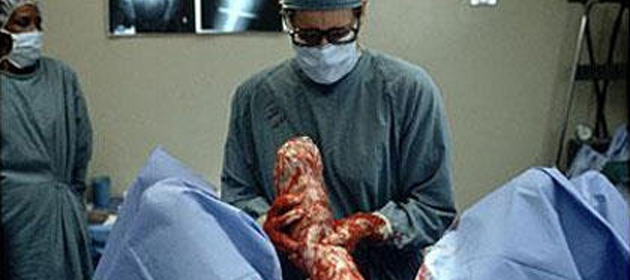
It’s not always easy to pinpoint one single moment that feels more WTF than others, especially in a movie whose entire concept is WTF to begin with. 1986’s remake of The Fly took the story in a more body-horror oriented direction, with Jeff Goldblum wetly squishing his way through the various stages of his journey to Brundlefly.
Goldblum plays Seth Brundle, charming but eccentric, a scientist with a dream. Early in the film he meets doe-eyed journalist Veronica Quaife (Geena Davis) and, eager to impress, escorts her back to his laboratory to show off the telepods: teleportation units that will (theoretically) allow instant travel between two points.
Making a deal to keep his secret in exchange for being able to break the story when the time is right, Veronica and Seth grow closer as the experiment moves through its stages. First completely unable to teleport live matter (a baboon is turned inside out in an attempt), but then that hurdle is cleared and it seems like Seth’s magnum opus will actually be successful.
One thing leads to another and soon Seth is mutated, Twilight Zone-style, by his experiments with the telepod. As he tests out the device on himself, he begins to see some pretty positive side effects of teleportation – namely, increased dreaminess and hunkiness, at first. This soon is traded in for such symptoms as corrosive vomit, raised wet veins all over the place, and a disconnect from his humanity (bummer). He says he will soon become Brundlefly, a human-insect hybrid, purified and strengthened by the telepod experience.
Veronica is very much not into this whole idea and watches with increasing distress as her lover drifts away from her for greener, gooier pastures. To make matters worse, she finds out that she is pregnant with Seth’s baby. The unborn child becomes a pretty major plot point – Veronica tries to get an emergency abortion and ends up kidnapped by Seth, by now so monstrous that all he can hope for is some shred of his humanity will live on in his baby.
Why is Veronica so keen to get rid of the baby? Likely nobody is asking that question, since she was impregnated by Brundlefly, but the movie decides it will give you an intimate look at this deep-seated fear of hers. Dream sequences are notoriously maligned as ‘cheat’ moments in film, but also happen to be excellent vehicles for complete madness.
The scene is a sudden left hook in a movie already rife with surprises. Trapped in an operating room as she howls her way through what must be a very difficult and sticky labour, Veronica’s moment of maternal horror plays out mercilessly.
The doctor, sweating and cursing, staggers back from her with a monstrous larva cradled in his arms. Veronica’s face is etched with terror, she screams endlessly as the doctor dutifully lays the larva out and tears it apart to get to the baby inside. The larva, taking after daddy, oozes thick white something everywhere. Veronica is presented with the writhing maggot and jolts awake, and immediately sets about finding a doctor for a late night house call. Understandably.
7. The Great Beauty – The painting
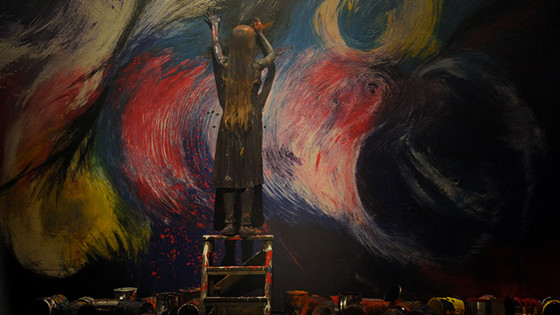
A film festival darling and critical juggernaut, The Great Beauty follows Jep – an ageing but renowned author (all he needed was one bestselling novel) who rules Rome’s opulent nightlife. After he turns 65 years old with precious little of substance to show for it, he slowly begins to connect with the world of beauty around him, pushing through the shallow veneer of night clubs and high-class socialites. Seeking companionship and fulfilment, he meets the beautiful Ramona (Sabrina Ferilli). For a time, she becomes his partner in languidly moving through the parties and empty decadence.
During one such party, a waiflike child emerges from the darkness with hollow cheeks and dark bags under her eyes. The revellers gather in silence to watch as the girl begins to scream and weep – she grabs up whole buckets of paint and flings them across a massive canvas. Not once throughout does she stop crying out in frustration and rage, smearing herself and the canvas with the paint, muddying the colours together. Jep, for his part, looks nonplussed.
The scene ends when Ramona uncomfortably removes herself from the crowd, leaving the little girl to bawl and continue her performance. The portrayal of contemporary art throughout is mixed with a reverence for Rome’s history, and scenes of beauty mingled with sadness or mystery are prevalent.
There’s a scene with a performance artist flinging herself against a wall, which she snottily defends, but the little girl’s painting scene has none of that pretension. She doesn’t want to be there, she doesn’t want to be creating anything, and she’s lost inside the work itself as just another piece of the creation. The scene is baffling, uncomfortable and wrenching – it will never come up again, as with the other moments of Jep’s strange life, but the kid is a hard one to forget.
8. Fire in the Sky – Alien abduction
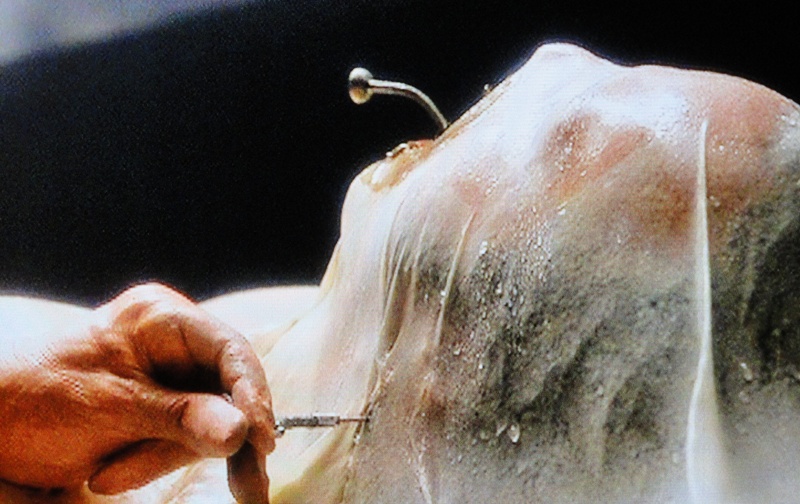
Telling the story of six friends in an unfortunate situation, Fire in the Sky is a slow-burn thriller (of sorts) directed by Robert Lieberman. A bit of a cult classic in its own right, Fire in the Sky was well-received but only took him modest box office earnings in 1993. It’s since gotten dusty as similar stories have been told and taken the limelight, but one scene has persisted and continues to startle audiences into whispering ‘WTF?’ at their screens.
Six friends heading home from work witness an incredible event – they stumble across a UFO, and one of the six, Walton (D.B. Sweeney) ventures in for a closer look. This is never a good idea, and in a flash of light, Walton is blasted by the UFO and his friends take off running.
It doesn’t take long for guilt to take hold, and the idea that Walton may have survived this experience. His brother in law, Mike (Robert Patrick) returns to the site but comes up empty-handed – the friends try to report Walton as missing and in danger but all they do is bring suspicion down on their heads. After a week of gruelling police interviews and manipulation, Walton reappears from the ether, whole but nude and disoriented.
The movie focuses more on relationships and human experience, an exercise in trauma and guilt and tenuous bonds. The sci-fi elements are present throughout but take a backseat until one fateful moment during a party thrown to welcome Walton home.
His trauma reawakened, Walton falls back into a flashback that will haunt audiences long after the credits roll. In stark contrast to the slow-burn build-up, the flashback sequence is harrowing, relentless, and explicit. Strapped down and carted through a sterile alien facility, Walton’s soulless captors torture and experiment on him with an assortment of imaginative, awful tools.
A mask is adhered to his face as his one uncovered eye desperately tries to see what is happening, what will be done to him. The aliens are uninterested in his psychological and physical suffering as they funnel oozing fluids into him and force needles into his eye, leaving no question about why Walton is so weird after returning home. The sequence is uncomfortably realistic and an experience all on its own.
The tabloids are all over Walton’s story and his friends are cleared of having anything to do with his experience. Walton is still a damaged man by the story’s end, and audiences are right there along with him.
9. Funny Games – Remote control
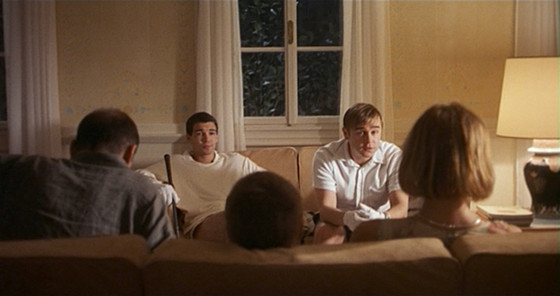
Funny Games is a 2007 remake of Michael Haneke’s film of the same name from 1997, with Haneke himself at the helm once again. An almost identical film in all respects except this one is in English and the locale is different, starring Naomi Watts and Tim Roth as George and Ann Farber, who are about to have a very terrible weekend at the lake house.
Shortly after they arrive, the Farbers meet Peter and Paul – one awkward and one confident and charming, two young men lurking around the area and making their uncomfortable presence known. After a few tense interactions between the boys and Ann in particular (and more than a few eggs), George gets his leg broken, the dog gets killed and things go very much off the rails.
Peter and Paul (rapidly changing the names they call each other) subject the Farbers and their son, Georgie, to an escalating series of sadistic games (one might call them funny games) and torment, all the while keeping up a rapid-fire rapport. The two young men give hints of the workings of their abusive friendship and alternate between Paul tearing Peter down, to good-naturedly betting if the family will live to see the next morning. The odds aren’t looking great.
A moment comes when Ann mounts a heroic effort to fight back, snatching a shotgun and blowing Peter away without hesitation. Viewers are rooting for her to get the hell out of there and save her family from this awful experience, but Paul flies into a rage and instead of slaughtering the family in revenge, starts to search for the television remote. When it’s in his clutches he promptly rewinds the entire scene, making sure that this time he grabs the shotgun before Ann can kill Peter. Ann has broken the rules, but Paul has a way of keeping the games on track.
There’s all kinds of debate and analysis about what this moment means – the movie isn’t shy about breaking mold to share a moment with its audience, sometimes coming across as more than a little contemptuous for anyone who happens to be watching. Sure, there’s hidden messages and critique of our relationship with violence as a society. None of that changes the fact the scene inspires a hearty, confused “WTF?”
10. Witches of Eastwick – Felicia vomit cherry pits
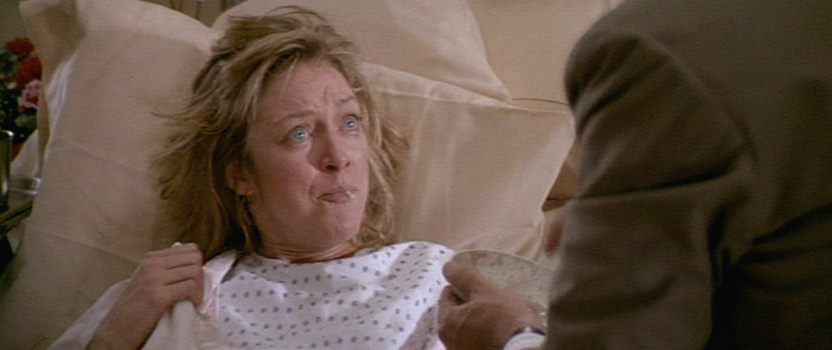
Jack Nicholson isn’t exactly a dreamboat, but as Daryl Van Horn in Witches of Eastwick, he has ways of getting a lady’s attention.
Alexandra, Sukie, and Jane (Cher, Michelle Pfeiffer and Susan Sarandon respectively) are three friends bored and dissatisfied with their lots in life, all three plodding through tales of abandonment and lost men. They drift together and become tight as they form a little club – you could possibly call it a coven.
When Daryl Van Horn rolls into town, the three women are aggressively courted and he reveals to them they are witches, each having some kind of power. This is good enough for them and the rivalry between the trio for Daryl’s affections cools some, as they all agree to share their gifts and also their wild-haired new suitor.
Besides his animal magnetism, Daryl also has a pretty serious ego problem. Speaking ill of him is quickly followed up by some kind of swift, mysterious retribution – bones are broken for making fun of his name, though this all happens by some unseen hand. A local religious fanatic, Felicia (Veronica Cartwright) has managed to avoid Daryl’s charms and she insists he is, in fact, Satan. Every neighbourhood needs a Felicia.
Talking badly about Daryl isn’t how they do things in Eastwick, and his three paramours unknowingly kick off a very bad evening for Felicia. Working herself up into a fit of suspicion over Daryl, Felicia stomps around her house, alternating between her ravings and attempting to coax her milquetoast husband into sex.
Across town, snacking ravenously on a huge bowl of cherries at Daryl’s insistence (“Have another cherry!”), the witches are oblivious as Felicia begins to vomit cherry pits in copious amounts. That’s the cliff notes version of what she goes through, best rest assured, there’s a lot of cherry pits.
Stand By Me has a notorious scene in which a pie-eating contest devolves into a puke-fest of epic proportions. Felicia mounts a one-woman challenge for most vomit expelled in a single movie, spewing across her living room as her husband uncertainly looks on. He eventually takes some fairly drastic steps to reclaim control of the situation, but it’s much too late to pull that WTF back into the stable.